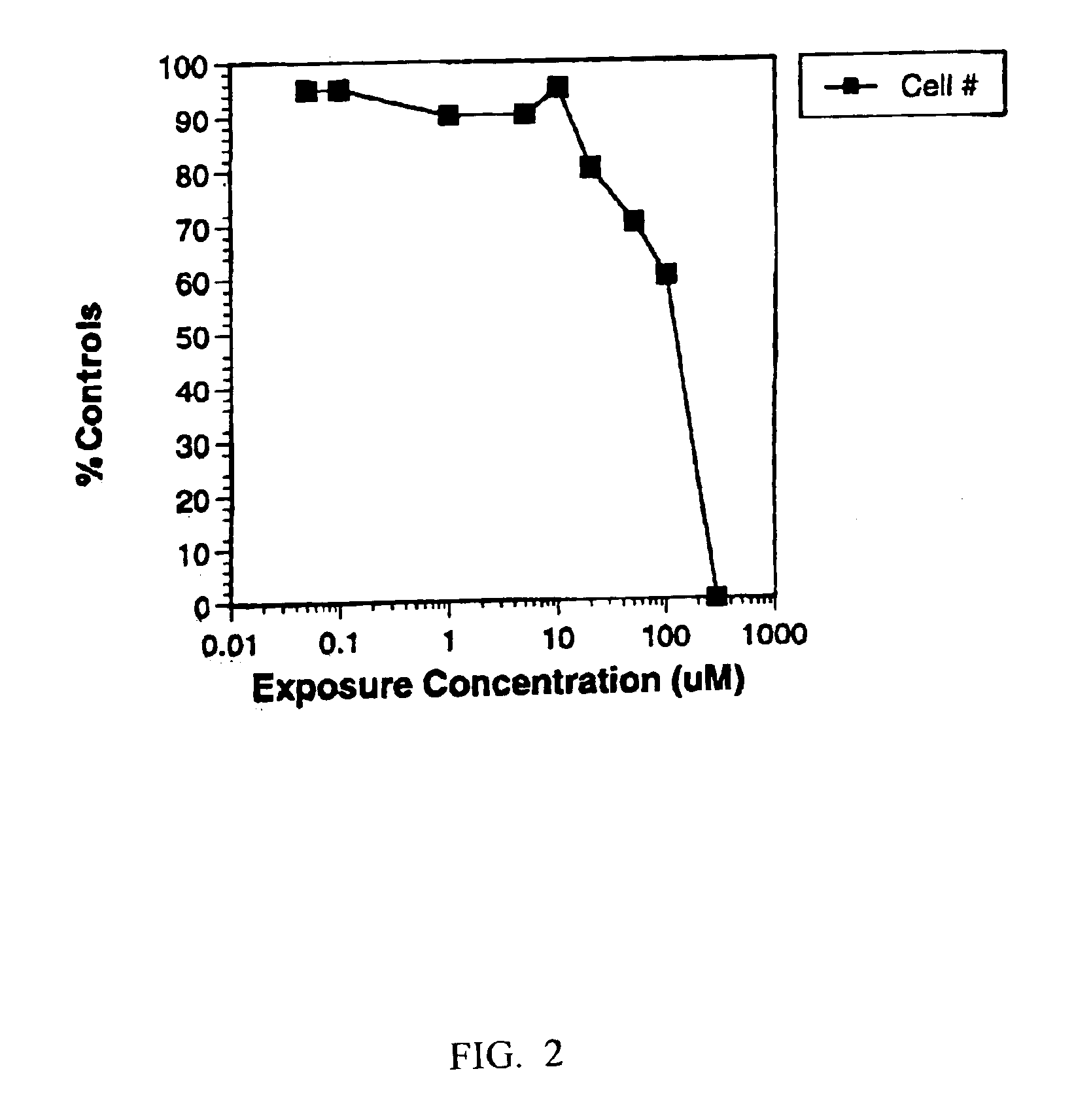Toxicity screening method
- Summary
- Abstract
- Description
- Claims
- Application Information
AI Technical Summary
Benefits of technology
Problems solved by technology
Method used
Image
Examples
example 1
Materials and Methods
[0118]The present Example describes exemplary materials and methods that may be employed in certain aspects of the present invention and were used to generate the results described in the subsequent Examples.
Preparation of Stock dosing solutions
[0119]The test compounds were received pre-weighed into glass vials. The preparation of 20 millimolar stock solutions was accomplished by adding a sufficient amount of dimethylsulfoxide (DMSO) directly into the vials. These stocks were used to prepare 200 micromolar stock solutions in DMSO. Both the 20 millimolar and 200 micromolar, stocks were used to prepare dosing solutions of 0.05, 0.1, 1.0, 5.0, 10.0, 20.0, 50.0, 100, and 300 micromolar in culture media with a final DMSO concentration of 0.5%. The stocks and dosing solutions were prepared on the day prior to dosing. The solutions were wrapped in foil and stored at 4° C. until the next morning.
Test and Control Articles
[0120]Negative controls of media plus DMSO (0.5%) ...
example 2
Ketoconazole: A drug of limited toxicity as determined by CATS
[0134]In this Example, ketoconazole was used as the test drug. Rat hepatoma cells were seeded into 96-well culture plates and allowed to establish growth for 48 hours. Following this growth phase, the cells were treated with 0, 0.05, 0.1, 1, 5, 10, 20, 50, 100, and 300 micromolar of ketoconazole in growth medium and 0.5% DMSO. After a 24 hour exposure period, the cells and surrounding media were analyzed as described in Example 1.
[0135]The effects of varying ketoconazole concentration was determined by measuring cell number (FIG. 2), GST leakage (FIG. 3), both cell number and the release of GST (FIG. 4), and an MTT assay or ATP assay (FIG. 5). Data from the cell number, GST leakage, MTT and ATP assays were combined to reveal a more complete picture of ketoconazole toxicity (FIG. 6A).
[0136]If only cell number was monitored for this compound the effect would be a dose-related reduction in cell number seen in FIG. 2. These d...
example 3
Comparison of toxicity of three antifungal compounds with ketoconazole
[0142]In this Example, the toxicity profiles of three azole antifungal compounds generated using the toxicity cluster analysis are compared to each other and to the well known antifungal drug, ketoconazole.
[0143]In the present Example, the effects of various concentrations of these three compounds were monitored using cell number, MTT, ATP, and GST leakage assays. The individual assays were conducted essentially as described above in Example 1. In the graph labeled “High Toxicity”, all four biochemical endpoints were affected in the same manner and magnitude with a TC50 near 10 micromolar (FIG. 9). In the graph labeled “Low Toxicity” the test compound had no effect on any of the assays evaluated (FIG. 10). In comparison, the data collected for a third compound presented in the graph labeled “Potentially Toxic-Unique Mechanism” only the ATP assay responded in a clear concentration dependent manner (FIG. 11).
[0144]T...
PUM
 Login to View More
Login to View More Abstract
Description
Claims
Application Information
 Login to View More
Login to View More - R&D
- Intellectual Property
- Life Sciences
- Materials
- Tech Scout
- Unparalleled Data Quality
- Higher Quality Content
- 60% Fewer Hallucinations
Browse by: Latest US Patents, China's latest patents, Technical Efficacy Thesaurus, Application Domain, Technology Topic, Popular Technical Reports.
© 2025 PatSnap. All rights reserved.Legal|Privacy policy|Modern Slavery Act Transparency Statement|Sitemap|About US| Contact US: help@patsnap.com



